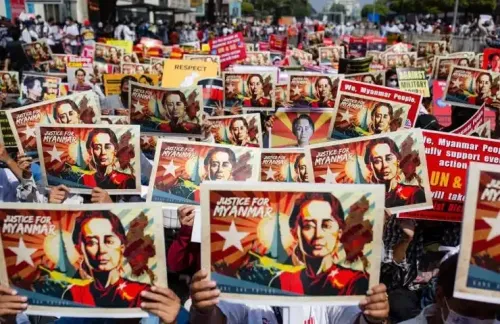Is Pakistan's Export Crisis a Self-Inflicted Wound? World Bank Issues Dire Warning

Synopsis
Key Takeaways
- Pakistan's export crisis is rooted in structural flaws.
- Export performance has declined significantly over the decades.
- The World Bank estimates potential losses of $60 billion.
- High energy costs hinder competitiveness.
- Trade agreements require urgent reform and better negotiation.
New Delhi, Nov 17 (NationPress) The World Bank has released a critical warning directed at Pakistan, stating that the nation’s export crisis has evolved from a temporary issue into a matter rooted in profound, enduring structural deficiencies.
In its latest evaluation, the institution points out that Pakistan's weak export performance stems from erratic policies, warped markets, and an ongoing failure to implement necessary reforms, as reported by The News International.
The World Bank strongly advises the Pakistani government to embrace a market-driven exchange rate, reduce elevated energy and input costs, and revise trade agreements that have yielded minimal advantages.
The report indicates a significant decline in Pakistan's export performance over the years. In the 1990s, exports constituted around 16 percent of GDP.
By 2024, this percentage plummeted to a mere 10 percent, while nations like Vietnam, Bangladesh, and India have experienced substantial growth. The World Bank estimates that Pakistan is missing out on approximately $60 billion in potential exports due to ineffective policies and governance issues.
A major concern cited in the report is the exchange rate system in Pakistan. The Bank advocates for a fully market-driven exchange rate, asserting that the State Bank of Pakistan should cease its interventions in the interbank market.
It argues that as long as the exchange rate remains politically controlled, Pakistan will suffer from cycles of artificial growth followed by external crises. A flexible exchange rate, it claims, will promote exports, draw in foreign investors, and diminish dollar speculation.
However, this transition demands political fortitude, as it may lead to short-term inflation.
The World Bank has also condemned the exorbitant cost of doing business in Pakistan, particularly due to high electricity rates and escalating input costs. Industrial electricity tariffs in Pakistan are nearly twice as high as those in competing nations like Bangladesh and Vietnam.
Heavy surcharges, cross-subsidies, and taxes exacerbate the situation, hindering industries from competing globally.
The report further identifies issues within Pakistan's manufacturing sector. Exporters face challenges such as elevated costs of imported inputs, sluggish tax refunds, power outages, and bureaucratic obstacles. These factors collectively undermine the nation's export competitiveness.
Pakistan's trade agreements have also come under the microscope. The nation maintains 10 bilateral and regional trade agreements, yet most are outdated and underutilized. The China-Pakistan Free Trade Agreement is the only one of significant depth, but it has predominantly benefited China.
Agreements with Malaysia, Sri Lanka, and other regional partners are limited in scope. The World Bank notes that Pakistan's trade negotiators lack the necessary technical expertise and industry consultation, leading to agreements that appear favorable on paper but offer little in practical terms.
It has recommended that the government enhance its trade negotiation teams and engage more closely with businesses, according to the report.
The report also sheds light on the burden of an oversized state apparatus in Pakistan. With over 200 federal state-owned enterprises and significant bureaucratic involvement, the private sector is frequently sidelined.
Discussions surrounding privatization, regulatory simplification, and governance reforms have been ongoing but remain unimplemented due to political opposition and vested interests, the report concluded.









